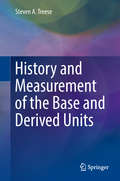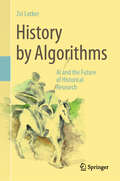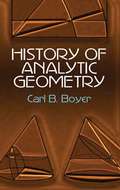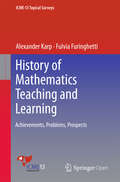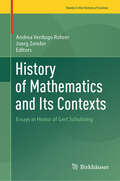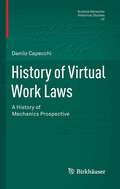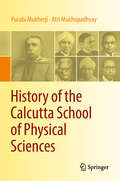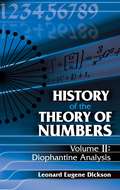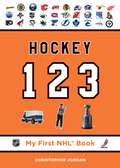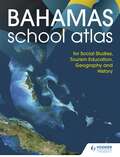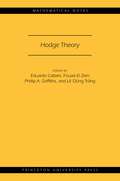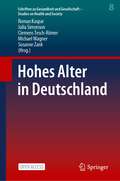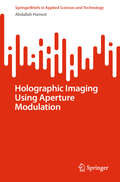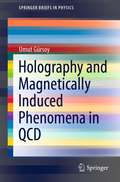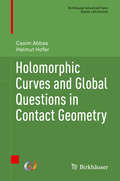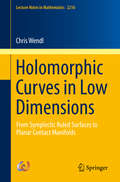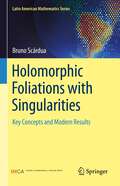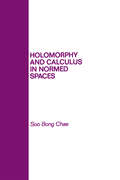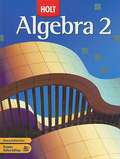- Table View
- List View
History and Measurement of the Base and Derived Units (Springer Series in Measurement Science and Technology)
by Steven A. TreeseThis book discusses how and why historical measurement units developed, and reviews useful methods for making conversions as well as situations in which dimensional analysis can be used. It starts from the history of length measurement, which is one of the oldest measures used by humans. It highlights the importance of area measurement, briefly discussing the methods for determining areas mathematically and by measurement. The book continues on to detail the development of measures for volume, mass, weight, time, temperature, angle, electrical units, amounts of substances, and light intensity. The seven SI/metric base units are highlighted, as well as a number of other units that have historically been used as base units. Providing a comprehensive reference for interconversion among the commonly measured quantities in the different measurement systems with engineering accuracy, it also examines the relationships among base units in fields such as mechanical/thermal, electromagnetic and physical flow rates and fluxes using diagrams.
History by Algorithms: AI and the Future of Historical Research
by Zvi LotkerThis book offers a first step towards getting machines to understand history in terms of analysing historical narratives. It uses computational intelligence and history texts as keys to ask different questions than have been asked about our human history so far. The book is divided into three main parts. The first part discusses the mathematical language of history, the second part uses simple models to analyse historical laws written in mathematical language, and the third part discusses the impact of general Large Language Models (LLMs) on the study of history.
History of Analytic Geometry: Its Development From The Pyramids To The Heroic Age (Dover Books on Mathematics)
by Carl B. BoyerSpecifically designed as an integrated survey of the development of analytic geometry, this classic study takes a unique approach to the history of ideas. The author, a distinguished historian of mathematics, presents a detailed view of not only the concepts themselves, but also the ways in which they extended the work of each generation, from before the Alexandrian Age through the eras of the great French mathematicians Fermat and Descartes, and on through Newton and Euler to the "Golden Age," from 1789 to 1850. Appropriate as an undergraduate text, this history is accessible to any mathematically inclined reader. 1956 edition. Analytical bibliography. Index.
History of Mathematics Teaching and Learning
by Alexander Karp Fulvia FuringhettiThis work examines the main directions of research conducted on the history of mathematics education. It devotes substantial attention to research methodologies and the connections between this field and other scholarly fields. The results of a survey about academic literature on this subject are accompanied by a discussion of what has yet to be done and problems that remain unsolved. The main topics you will find in ICME-13 Topical Survey include: Discussions of methodological issues in the history of mathematics education and of the relation between this field and other scholarly fields. The history of the formation and transformation of curricula and textbooks as a reflection of trends in social-economic, cultural and scientific-technological development. The influence of politics, ideology and economics on the development of mathematics education, from a historical perspective. The history of the preeminent mathematics education organizations and the work of leading figures in mathematics education. Mathematics education practices and tools and the preparation of mathematics teachers, from a historical perspective. "
History of Mathematics and Its Contexts: Essays in Honor of Gert Schubring (Trends in the History of Science)
by Andrea Verdugo Rohrer Joerg ZenderThis book celebrates Gert Schubring's 80th birthday and honors his impactful contributions to the field of history of mathematics and its education. Recognized with the prestigious Hans Freudenthal Award in 2019, Schubring's academic work sets the tone for this volume. The thoughtfully curated articles in this collection offer insightful studies on textbooks and biographies of key figures in mathematics and mathematics education, contextualizing their significance within the broader historical landscape, and providing the readers with a deeper understanding of the development of the history of mathematics and its education. Researchers as well as curious readers and students will find this collection to be a valuable resource in the field.
History of Virtual Work Laws
by Danilo CapecchiThe book presents a history of classical mechanics by focusing on issues of equilibrium. The historical point of view adopted here restricts attention to cases where the effectiveness of forces is assessed on the basis of the virtual motion of their points of application. For completeness, hints of the alternative approach are also referred, the Archimedean for ancient mechanics and the Newtonian for modern mechanics. The laws resulting from consideration of virtual motions are named laws of virtual work. The modern formulations of the principle of virtual work are only a particular form of them. The book begins with the first documented formulations of laws of virtual work in the IV century BC in Greece and proceeds to the end of the XIX century AD in Europe. A significant space is devoted to Arabic and Latin mechanics of Middle Ages. With the Renaissance it began to appear slightly different wordings of the laws, which were often proposed as unique principles of statics. The process reached its apex with Bernoulli and Lagrange in the XVIII century. The book ends with some chapters dealing with the discussions that took place in the French school on the role of the Lagrangian version of the law of virtual work and its applications to continuum mechanics.
History of the Calcutta School of Physical Sciences
by Purabi Mukherji Atri MukhopadhyayThis book highlights the role of Sir Asutosh Mookerjee, founder of the Calcutta school of physics and the Calcutta Mathematical Society, and his talented scholars – Sir C.V. Raman, D.M. Bose, S.N. Bose, M.N. Saha, Sir K.S. Krishnan and S.K. Mitra – all of whom played a significant role in fulfilling their goal of creating an outstanding school of physical sciences in the city of Calcutta. The main objective of the book is to bring to the fore the combined contributions of the greatest physicists of India, who in the colonial period worked with practically no modern amenities and limited financial resources, but nonetheless with total dedication and self-confidence, which is unmatched in today’s world. The book presents the golden age of the physical sciences in India in compact form; in addition, small anecdotes, mostly unknown to many, have been brought the forefront. The book consists of 10 chapters, which include papers by these distinguished scientists along with detailed accounts of their academic lives and main research contributions, particularly during their time in Calcutta. A synopsis of the contents is provided in the introductory chapter. In the following chapters, detailed discussions are presented in straightforward language. The complete bibliographies of the great scientists have been added at the end. This book will be of interest to historians, philosophers of science, linguists, anthropologists, students, research scholars and general readers with a love for the history of science.
History of the Theory of Numbers, Volume II: Diophantine Analysis
by Leonard Eugene DicksonThe three-volume series History of the Theory of Numbers is the work of the distinguished mathematician Leonard Eugene Dickson, who taught at the University of Chicago for four decades and is celebrated for his many contributions to number theory and group theory. This second volume in the series, which is suitable for upper-level undergraduates and graduate students, is devoted to the subject of diophantine analysis. It can be read independently of the preceding volume, which explores divisibility and primality, and volume III, which examines quadratic and higher forms.Featured topics include polygonal, pyramidal, and figurate numbers; linear diophantine equations and congruences; partitions; rational right triangles; triangles, quadrilaterals, and tetrahedra; the sums of two, three, four, and n squares; the number of solutions of quadratic congruences in n unknowns; Liouville's series of eighteen articles; the Pell equation; squares in arithmetical or geometrical progression; equations of degrees three, four, and n; sets of integers with equal sums of like powers; Waring's problem and related results; Fermat's last theorem; and many other related subjects. Indexes of authors cited and subjects appear at the end of the book.
Hockey 123 (My First NHL Book)
by Christopher JordanWhat better way to introduce your child to the action-packed world of hockey than through a new series of books aimed at the youngest of hockey fans? Published with the NHL® and the NHLPA, this great series introduces essential early concepts through the fun and entertaining world of hockey. Count players, sticks, and Stanley Cups; explore the colours of the rainbow through team logos and sweaters; look for familiar shapes amongst pucks, scoreboards and nets, and work your way through an alphabet that includes everything, from Arenas to Zambonis®!
Hockey 123 (My First NHL Book)
by Christopher JordanWhat better way to introduce your child to the entertaining, action-packed world of hockey than through a new series of books aimed at the youngest of hockey fans? Published through the combined efforts of the NHL, the NHLPA and Fenn/Tundra, My First NHL Books introduce preschool readers to the essential early concepts of learning through the fun and entertaining themes of hockey. Count players, sticks and Stanley cups, explore the colours of the rainbow through team logos and sweaters; look for familiar shapes amongst pucks, scoreboards and nets, and work your way through an alphabet that includes everything from A is for Arena to Z is for Zamboni, and everything hockey in between.
Hodder Education School Atlas for the Commonwealth of The Bahamas
by Professor Michael MorrisseyEnsure full coverage of the curriculum requirements with an atlas specially created to cover Social Studies, Tourism Education, Geography and History.- Encourage awareness of the region with a specially designed 18-page section of detailed maps of The Bahamas supplemented by up-to-date diagrams, graphs and photographs. Climate, environment, tourism, history, major cities, agriculture, transportation networks and the Family Islands all covered.- Engage students in topical issues with a 14-page Caribbean section that shows The Bahamas in the context of the CARICOM community, focusing on topics that impact all CARICOM citizens including hurricanes, earthquakes, volcanoes, climate, environment and tourism- Introduce a solid foundation in geographical knowledge with detailed maps and facts about all the major countries of the Caribbean.- Secure strong geographical knowledge with comprehensive maps of each of the world's continents plus a World Data section with facts, figures and flags of every country and features on the Solar System, the Seasons and World Organisations.- Ensure ease-of-use with a four-page easy-to-use index with guidance on how to locate places and an introduction to geographical skills showing how to use a map, the importance of scale and how to measure distances.
Hodge Theory and Complex Algebraic Geometry I
by Claire VoisinThe first of two volumes offering a modern introduction to Kaehlerian geometry and Hodge structure. The book starts with basic material on complex variables, complex manifolds, holomorphic vector bundles, sheaves and cohomology theory, the latter being treated in a more theoretical way than is usual in geometry. The author then proves the Kaehler identities, which leads to the hard Lefschetz theorem and the Hodge index theorem. The book culminates with the Hodge decomposition theorem. The meanings of these results are investigated in several directions. Completely self-contained, the book is ideal for students, while its content gives an account of Hodge theory and complex algebraic geometry as has been developed by P. Griffiths and his school, by P. Deligne, and by S. Bloch. The text is complemented by exercises which provide useful results in complex algebraic geometry.
Hodge Theory and Complex Algebraic Geometry II
by Leila SchnepsThe 2003 second volume of this account of Kaehlerian geometry and Hodge theory starts with the topology of families of algebraic varieties. Proofs of the Lefschetz theorem on hyperplane sections, the Picard–Lefschetz study of Lefschetz pencils, and Deligne theorems on the degeneration of the Leray spectral sequence and the global invariant cycles follow. The main results of the second part are the generalized Noether–Lefschetz theorems, the generic triviality of the Abel–Jacobi maps, and most importantly Nori's connectivity theorem, which generalizes the above. The last part of the book is devoted to the relationships between Hodge theory and algebraic cycles. The book concludes with the example of cycles on abelian varieties, where some results of Bloch and Beauville, for example, are expounded. The text is complemented by exercises giving useful results in complex algebraic geometry. It will be welcomed by researchers in both algebraic and differential geometry.
Hodge Theory: Proceedings, U. S. -spain Workshop Held In Sant Cugat (barcelona), Spain, June 24-30 1985 (Mathematical Notes #49)
by Phillip A. Griffiths Lê Dũng Tráng Eduardo Cattani Fouad El ZeinThis book provides a comprehensive and up-to-date introduction to Hodge theory—one of the central and most vibrant areas of contemporary mathematics—from leading specialists on the subject. The topics range from the basic topology of algebraic varieties to the study of variations of mixed Hodge structure and the Hodge theory of maps. Of particular interest is the study of algebraic cycles, including the Hodge and Bloch-Beilinson Conjectures. Based on lectures delivered at the 2010 Summer School on Hodge Theory at the ICTP in Trieste, Italy, the book is intended for a broad group of students and researchers. The exposition is as accessible as possible and doesn't require a deep background. At the same time, the book presents some topics at the forefront of current research.The book is divided between introductory and advanced lectures. The introductory lectures address Kähler manifolds, variations of Hodge structure, mixed Hodge structures, the Hodge theory of maps, period domains and period mappings, algebraic cycles (up to and including the Bloch-Beilinson conjecture) and Chow groups, sheaf cohomology, and a new treatment of Grothendieck’s algebraic de Rham theorem. The advanced lectures address a Hodge-theoretic perspective on Shimura varieties, the spread philosophy in the study of algebraic cycles, absolute Hodge classes (including a new, self-contained proof of Deligne’s theorem on absolute Hodge cycles), and variation of mixed Hodge structures.The contributors include Patrick Brosnan, James Carlson, Eduardo Cattani, François Charles, Mark Andrea de Cataldo, Fouad El Zein, Mark L. Green, Phillip A. Griffiths, Matt Kerr, Lê Dũng Tráng, Luca Migliorini, Jacob P. Murre, Christian Schnell, and Loring W. Tu.
Hohes Alter in Deutschland (Schriften zu Gesundheit und Gesellschaft - Studies on Health and Society #8)
by Michael Wagner Clemens Tesch-Römer Julia Simonson Roman Kaspar Susanne ZankDies ist ein Open-Access-Buch.Trotz des schnellen Wachstums des Anteils der Bevölkerung in einem Alter ab 80 Jahren an der Gesamtbevölkerung ist das Wissen über diese Bevölkerungsgruppe bislang gering. Zwar gibt es thematisch, methodisch und regional spezifische Studien, jedoch keine repräsentative Erfassung der Lebenssituation und Lebensqualität dieser Altersgruppe für den gesamtdeutschen Raum. Eine gute Datenlage ist jedoch notwendig: Zum einen, um den besonderen Unterstützungsbedarfen im hohen Alter zukünftig besser gerecht werden zu können. Zum anderen, um Lösungsansätze für sozialpolitische Herausforderungen wie der sozialen Sicherung im Alter sowie im Hinblick auf eine Generationengerechtigkeit entwickeln zu können. Schließlich, um negativen Altersbildern und Vorurteilen über die Lebensqualität im hohen Alter empirisch fundiert entgegenwirken zu können. Die Studie "Hohes Alter in Deutschland“ (D80+) ist eine bundesweit repräsentative Querschnittsbefragung der hochaltrigen Menschen in Privathaushalten und in Heimen. Sie wird vom Bundesministerium für Familie, Senioren, Frauen und Jugend (BMFSFJ) gefördert und gemeinsam vom Cologne Center for Ethics, Rights, Economics, and Social Sciences of Health (ceres) und dem Deutschen Zentrum für Altersfragen (DZA) durchgeführt. Die Studie vereint Perspektiven der an den beteiligten Institutionen verorteten Disziplinen wie Soziologie, Psychologie, Versorgungswissenschaften, Gerontologie und Medizin. Im vorliegenden Band werden zentrale Befunde u.a. zu den Themenbereichen Soziale und Digitale Teilhabe, Gesundheit und Versorgung, sowie Werte und subjektives Wohlbefinden vorgestellt.
Holographic Imaging Using Aperture Modulation (SpringerBriefs in Applied Sciences and Technology)
by Abdallah HamedThis book highlights the formation of holographic images using modulated apertures across eleven comprehensive chapters. It begins with a summary of basic Fourier transformations used to compute diffraction patterns of well-known objects. The fundamentals of holography are outlined, followed by an investigation of Fourier holographic images obtained using argon plasma. This book also explores Fourier holographic images using modulated Hamming apertures and discusses the use of scanning holography with linear and quadratic apertures. Advanced topics include the processing and segmentation of cancerous mammographic images using improved Fourier holograms, and the detailed study of Fourier holographic imaging of modulated apertures. The recognition of colored objects and the computation of the point spread function (PSF) using operator algebra in Gaussian beam illumination are also covered. This book concludes with a discussion on pattern recognition and information processing. This book serves as an essential resource for researchers and students interested in the advanced techniques and applications of holographic imaging.
Holography and Magnetically Induced Phenomena in QCD (SpringerBriefs in Physics)
by Umut GürsoyThis book introduces the traditional and novel techniques required to study the thermodynamic and transport properties of quark–gluon plasma. In particular, it reviews the construction of improved holographic models for QCD-like confining gauge theories and their applications in the physics of quark–gluon plasma. It also discusses the recent advances in the development of hydrodynamic techniques, especially those incorporating the effects of external magnetic fields on transport. The book is primarily intended for researchers and graduate students with a background in quantum field theory and particle physics but who may not be familiar with the theory of strong interactions and holographic and hydrodynamic techniques required to study said interactions.
Holomorphic Curves and Global Questions in Contact Geometry (Birkhäuser Advanced Texts Basler Lehrbücher)
by Casim Abbas Helmut HoferThis book explains the foundations of holomorphic curve theory in contact geometry. By using a particular geometric problem as a starting point the authors guide the reader into the subject. As such it ideally serves as preparation and as entry point for a deeper study of the analysis underlying symplectic field theory.An introductory chapter sets the stage explaining some of the basic notions of contact geometry and the role of holomorphic curves in the field. The authors proceed to the heart of the material providing a detailed exposition about finite energy planes and periodic orbits (chapter 4) to disk filling methods and applications (chapter 9).The material is self-contained. It includes a number of technical appendices giving the geometric analysis foundations for the main results, so that one may easily follow the discussion. Graduate students as well as researchers who want to learn the basics of this fast developing theory will highly appreciate this accessible approach taken by the authors.
Holomorphic Curves in Low Dimensions: From Symplectic Ruled Surfaces to Planar Contact Manifolds (Lecture Notes in Mathematics #2216)
by Chris WendlThis monograph provides an accessible introduction to the applications of pseudoholomorphic curves in symplectic and contact geometry, with emphasis on dimensions four and three. The first half of the book focuses on McDuff's characterization of symplectic rational and ruled surfaces, one of the classic early applications of holomorphic curve theory. The proof presented here uses the language of Lefschetz fibrations and pencils, thus it includes some background on these topics, in addition to a survey of the required analytical results on holomorphic curves. Emphasizing applications rather than technical results, the analytical survey mostly refers to other sources for proofs, while aiming to provide precise statements that are widely applicable, plus some informal discussion of the analytical ideas behind them. The second half of the book then extends this program in two complementary directions: (1) a gentle introduction to Gromov-Witten theory and complete proof of the classification of uniruled symplectic 4-manifolds; and (2) a survey of punctured holomorphic curves and their applications to questions from 3-dimensional contact topology, such as classifying the symplectic fillings of planar contact manifolds. This book will be particularly useful to graduate students and researchers who have basic literacy in symplectic geometry and algebraic topology, and would like to learn how to apply standard techniques from holomorphic curve theory without dwelling more than necessary on the analytical details. This book is also part of the Virtual Series on Symplectic Geometry http://www.springer.com/series/16019
Holomorphic Foliations with Singularities: Key Concepts and Modern Results (Latin American Mathematics Series)
by Bruno ScárduaThis concise textbook gathers together key concepts and modern results on the theory of holomorphic foliations with singularities, offering a compelling vision on how the notion of foliation, usually linked to real functions and manifolds, can have an important role in the holomorphic world, as shown by modern results from mathematicians as H. Cartan, K. Oka, T. Nishino, and M. Suzuki.The text starts with a gentle presentation of the classical notion of foliations, advancing to holomorphic foliations and then holomorphic foliations with singularities. The theory behind reduction of singularities is described in detail, as well the cases for dynamics of a local diffeomorphism and foliations on complex projective spaces. A final chapter brings recent questions in the field, as holomorphic flows on Stein spaces and transversely homogeneous holomorphic foliations, along with a list of open questions for further study and research. Selected exercises at the end of each chapter help the reader to grasp the theory.Graduate students in Mathematics with a special interest in the theory of foliations will especially benefit from this book, which can be used as supplementary reading in Singularity Theory courses, and as a resource for independent study on this vibrant field of research.
Holomorphy and Calculus in Normed SPates
by Soo Bong ChaeThis book presents a systematic introduction to the theory of holomorphic mappings in normed spaces which has been scattered throughout the literature. It gives the necessary, elementary background for all branches of modern mathematics involving differential calculus in higher dimensional spaces.
Holt Algebra 1
by Paul A. Kennedy James E. Schultz Kathleen A. Hollowell Wade Ellis Jr.A textbook on Algebra.
Holt Algebra 2
by David J. Chard Earlene J. Hall Edward B. Burger Paul A. Kennedy Freddie L. Renfro Bert K. Waits Steven J. Leinwand Dale G. SeymourAlgebra 2 covers several methods for solving quadratic equations, such as factoring, completing the square, and graphing. The text also introduces trigonometry and exponential functions--vital concepts for real world applications.
